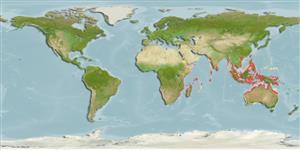Пластиножаберные (акулы и скаты) (sharks and rays) >
Rhinopristiformes (Shovelnose rays) >
Pristidae (Sawfishes)
Etymology: Pristis: Greek, pristis = saw (Ref. 45335).
Issue
Synonym of Pristis pristis (Linnaeus, 1758) according to Faria et al., 2012 (Ref. 93006:11) and Weigmann, 2016 (Ref. 106604); status confirmed by William White (pers. Comm., Feb 2016).
Environment: milieu / climate zone / depth range / distribution range
экология
морской; пресноводный; солоноватоводный демерсальный; амфидромный (Ref. 51243); пределы глубины 0 - 10 m (Ref. 27000). Tropical; 22°N - 39°S, 20°E - 154°E
Indo-West Pacific: East Africa to New Guinea, north to the Philippines and Viet Nam, south to Australia. Also Atlantic and eastern Pacific if Pristis perotteti and Pristis zephyreus are synonymized with this species. The original description of Pristis microdon did not give a locality, but most authors have used the name Pristis microdon for the Indo-West Pacific sawfishes of this species group as contrasted from the Atlantic Pristis perotteti and the eastern Pacific Pristis zephyreus.
Length at first maturity / Size / Вес / Возраст
Maturity: Lm 270.0, range 240 - 300 cm
Max length : 700 cm TL самец/пол неопределен; (Ref. 58048); common length : 500 cm TL самец/пол неопределен; (Ref. 2683); наибольший вес (опубликованные данные): 600.0 kg (Ref. 3164); наибольший возраст (опубликованны данные): 30 годы (Ref. 9859)
колючие лучи спинного плавника (общее число) : 0; колючие лучи анального плавника: 0. Diagnosis: A heavily-bodied sawfish with a short but massive saw which is broad-based, strongly tapering and with 14-22 very large teeth on each side; space between last 2 saw-teeth on sides less than 2 times space between first 2 teeth (Ref. 5578). Pectoral fins high and angular, 1st dorsal fin mostly in front of pelvic fins, and caudal fin with pronounced lower lobe (Ref. 5578).
Inhabits sandy or muddy bottoms of shallow coastal waters, estuaries, river mouths, and freshwater rivers and lakes. Usually found in turbid channels of large rivers over soft mud bottoms (Ref. 2847, 44894). Adults usually found in estuaries and young ascend into fresh water. Large adults can also be found in fresh water, but are rarely caught (Ref. 12693). Feeds on benthic animals and small schooling species. Ovoviviparous (Ref. 50449). The saw is used for grubbing and attacking prey as well as for defense. The saws sell as tourist souvenirs (Ref. 7248). Occasionally caught by demersal tangle net and trawl fisheries in the Arafura Sea; possibly extinct in parts of the Indo-Pacific; highly susceptible to gill nets. Utilized for its fins and meat (both of very high value), and skin and cartilage (Ref.58048). Attains 4.6 m total length (Ref. 52193).
Life cycle and mating behavior
Maturities | размножение | Spawnings | Egg(s) | Fecundities | личинки
Ovoviviparous, embryos feed solely on yolk (Ref. 50449). Gestation period about 5 months (Ref. 9859); litter size 1- 13 (Ref. 5578). Probably breeds in freshwater (Ref.58048).
Last, P.R. and J.D. Stevens, 1994. Sharks and rays of Australia. CSIRO, Australia. 513 p. (Ref. 6871)
Статус Красного Списка МСОП (Ref. 130435)
Угроза для людей
Traumatogenic (Ref. 4690)
Использование человеком
рыболовство: не имеет хозяйственного значения; объект спортивного рыболовства: да
дополнительная информация
инструменты
Специальные отчеты
Скачать в формате XML
ресурсы в Интернет
Estimates based on models
Preferred temperature (Ref.
123201): 24.6 - 29.2, mean 28.5 °C (based on 2653 cells).
Phylogenetic diversity index (Ref.
82804): PD
50 = 0.5234 [Uniqueness, from 0.5 = low to 2.0 = high].
Bayesian length-weight: a=0.00501 (0.00198 - 0.01270), b=3.05 (2.83 - 3.27), in cm total length, based on LWR estimates for this (Sub)family-body shape (Ref.
93245).
Trophic level (Ref.
69278): 3.9 ±0.61 se; based on food items.
устойчивость к внешним воздействиям (Ref.
120179): очень низкий, минимальное время удвоения популяции более 14 лет (tm=10; tmax=30; Fec=1).
Fishing Vulnerability (Ref.
59153): Very high vulnerability (90 of 100).
Nutrients (Ref.
124155): Calcium = 13.9 [3.0, 64.7] mg/100g; Iron = 0.512 [0.120, 1.459] mg/100g; Protein = 19.4 [17.2, 21.6] %; Omega3 = 0.0888 [, ] g/100g; Selenium = 53.2 [15.0, 189.9] μg/100g; VitaminA = 4.43 [1.44, 13.30] μg/100g; Zinc = 0.681 [0.321, 1.284] mg/100g (wet weight);
